#sandarac
Explore tagged Tumblr posts
Text
A-Z Dictionary of Esoteric Terminology

for your next poem/story (pt. 1)
Esoteric—designed for or understood by the specially initiated alone; may refer to the occult
Affenicum - a word for soul
Barakah - soul power; a blessing bestowed by a holy person
Cthonian - something associated with the earth and the underworld
Deity - the personification of some force or concept of great magnitude; a being embodying the essence or entirety of an aspect of existence
Egrigor - a thought form created by will and visualization
Fana - a Sufi term meaning "becoming absorbed in God"
Godhead - divine Nature or Essence; the source of all emanation and manifestation, of which all deities are but aspects or facets
Host - from the Latin hostia, meaning "a sacrificial victim"
Ineffable name - a name for God which either must not or cannot be spoken
Jnana - literally "primordial knowing"; wisdom; the activity of enlightenment; knowing, which transcends all dualistic conception; perfect intuition
Kalpa - the longest describable span of time
Libation - the act of pouring a liquid on a symbolic figure of a deity, or on the ground
Mania - a Roman goddess of the dead who ruled over the lares and manes in the underworld; she is sometimes called the "Mother of Ghosts"
Neti - literally, "not this, not that"; it refers to the idea that the supreme godhead is transcendent and cannot be described or understood
Occult - from Latin occuiere, "to cover up"; not revealed; secret; mysterious
Pantheon - from Greek pantheios, "of all gods"; the arrangement or hierarchy of deities and spirits within a particular system
Qlippoth - literally "shells"; usually described as a plane/s containing demons, negative or disintegrating spirits, elementals, and the degenerating shells of the dead
Rapport - resonance; an interface relationship involving energy exchange such as the relationship between hypnotist and subject, control and medium, or object and psychometrist
Sandarace - an alchemical term for the fiery form of Spirit
Thaumaturgy - miracle working; magic used to make overt changes in the material world
Unction - ceremonial anointment with oil; sometimes performed as an act of consecration; also used in rites for the severely ill or dying, as in the case of extreme unction; in ceremonial magic, unction is often used as a symbol of the quest for initiation, or the dedication (consecration) of the magician to enlightenment
Vac - literally "speech" or "word"; cosmic reason or pattern, somewhat similar to the Greek idea of Logos
Wic - an Old English word meaning "to bend, to twist, or to wiggle"; a very old term for the practice of magic; also had been translated as "to weave, or to know"
Xeni Nephidei - spirits who delight to reveal to people the hidden properties of nature
Yaksha - a nature spirit which resides in a tree, usually regarded as female; are said to accompany Kubera, the god of wealth
Zen - a system of mental stillness originating in India, where it was known as dhyana; the goal is to permit experience by direct perception or intuition
Source ⚜ More: Word Lists
#esoteric#terminology#writing reference#dark academia#writeblr#langblr#spilled ink#writers on tumblr#poets on tumblr#writing prompt#literature#poetry#creative writing#lit#light academia#novel#writing inspiration#writing ideas#pierre puvis de chavannes#writing resources
140 notes
·
View notes
Text
Got drawn down the rabbit hole of armour painting and found both some really beautiful examples, and some great info!

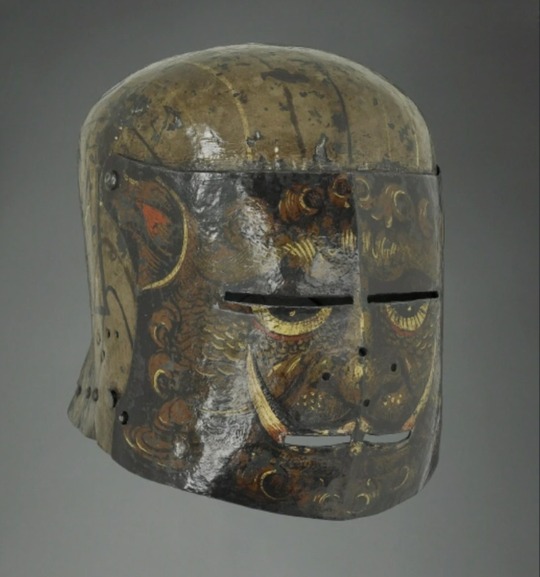

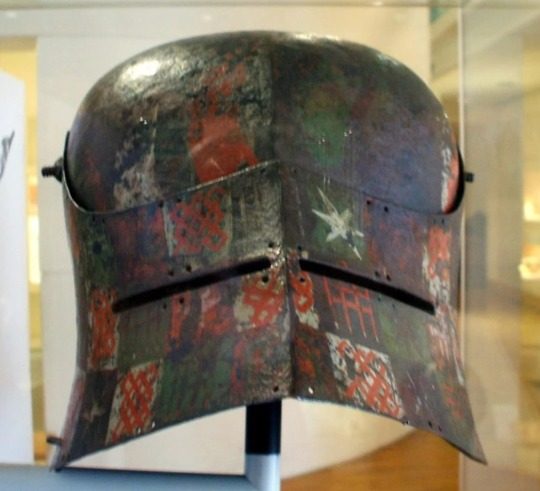
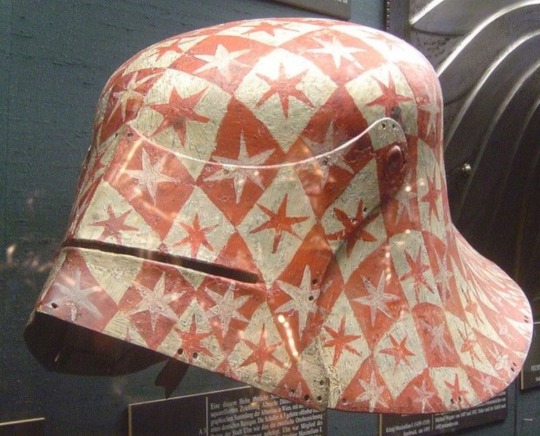

From what I've read so far, most pieces of painted armour, from the few examples that still exist, were painted with egg tempera (a type of egg based paint, not the batter on fried Japanese food lol), and a layer of gesso, a gluey paste made from animal skin glue -rabbit seems to be traditional- and powdered calcium carbonate (aka chalk). The gesso would be applied to the plate first, to give a better surface for the tempera to adhere to. Here's a good video about gesso:
youtube
After the gesso dried you could begin painting with various pigments. I found a fantastic video from a very talented iconographer who explains mixing and painting with tempera -still commonly used in iconography today.
youtube
After the gesso and painting were finished, some sort of varnish would be added to protect the paint. I'm not sure what was used for the varnish, but I've read that painting and furniture varnishes were sometimes made from sandarac resin and linseed oil. Other cheaper/regionally available alternatives to sandarac, could have been used, such as resins from other types trees and various mixtures of linseed and copal oils. Most modern tempera painters seem to use acrylic varnishes to preserve their works.
The gesso/tempera/varnish process wasn't just used for armour and paintings, there are also examples of gesso being used on shield faces to adhere fabric and strengthen the shield and give a paintable surfface to work with.
Bonus facts:
There seem to be medieval texts (I'm unsure if there are any actual examples) that also describe a completely different process of covering armour in cloth or leather rather than paint to preserve it.
‘𝟷 𝚖𝚊𝚒𝚕 𝚜𝚑𝚒𝚛𝚝 𝚌𝚊𝚕𝚕𝚎𝚍 𝙱𝚘𝚕𝚒𝚘𝚞𝚗, 𝟷 𝚙𝚊𝚒𝚛 𝚘𝚏 𝚙𝚕𝚊𝚝𝚎𝚜 𝚌𝚘𝚟𝚎𝚛𝚎𝚍 𝚠𝚒𝚝𝚑 𝚐𝚛𝚎𝚎𝚗 𝚟𝚎𝚕𝚟𝚎𝚝, 𝟸 𝚓𝚞𝚙𝚘𝚗𝚜, 𝟸 𝚌𝚘𝚊𝚝𝚜 𝚠𝚒𝚝𝚑 𝚝𝚑𝚎 𝚊𝚛𝚖𝚜 𝚘𝚏 𝚝𝚑𝚎 𝚎𝚊𝚛𝚕, 𝚝𝚑𝚛𝚎𝚎 𝚙𝚊𝚒𝚛𝚜 𝚘𝚏 𝚊𝚒𝚕𝚎𝚝𝚝𝚎𝚜 𝚠𝚒𝚝𝚑 𝚝𝚑𝚎 𝚊𝚛𝚖𝚜 𝚘𝚏 𝚝𝚑𝚎 𝚎𝚊𝚛𝚕 𝚘𝚏 𝙷𝚎𝚛𝚎𝚏𝚘𝚛𝚍’, 𝚊𝚗𝚍 ‘𝟸 𝚋𝚊𝚌𝚒𝚗𝚎𝚝𝚜, 𝟷 𝚌𝚘𝚟𝚎𝚛𝚎𝚍 𝚠𝚒𝚝𝚑 𝚕𝚎𝚊𝚝𝚑𝚎𝚛, 𝚝𝚑𝚎 𝚘𝚝𝚑𝚎𝚛 𝚋𝚛𝚒𝚐𝚑𝚝’.
-Inventory of Humphrey de Bohun, earl of Hereford (1319-22)
I haven't researched this process much as there doesn't seem to be a lot of available information, but I would assume it follows a similar process of using gesso to glue the material to the armour. I just thought it was interesting and worth mentioning. ¯\_(ツ)_/¯
16 notes
·
View notes
Text
“E” or “O”...?
A comment in the “It Was Sugar!” post wondered if "castor" with an "O" was the American spelling for caster sugar, or a typo.
It’s a typo, but one with an interesting history.
*****
“CastOr” is the spelling when referring to castor oil (pressed from castor beans) and, even older, a hat made from felted beaver fur (Castor canadiensis).
Fans of historical fiction might occasionally read that a character “doffed their castor” - meaning, raised or removed their hat in a token of good manners to ladies or respect to superiors.
"CastEr" is the spelling for a container (or its contents) for strewing, sprinkling or throwing, as in "cast aside" or “cast a shadow”.
In homophones (same-sounding words) such as sow / sew, rein / rain, peal / peel, breach / breech etc., just one letter gives the different meaning.
Words like “cast”, however, depend on context - cast a spell, cast a bell, cast a role, arm in a cast, cast in an eye, cast of the show...
English is like that.
*****
Besides sugar casters for sprinkling sugar, there were “sand casters” of wood, ceramic or metal, which contained the powder used to blot ink before or instead of blotting-paper.


This powder might be fine sand or ground sandarac resin (two reasons for “sand caster”) but also ground cuttlefish bone, or ground pumice which was called “pounce” - the French for pumice stone is “pierre ponce” - in which case the container was called a “pounce pot”.
Blotting a letter with sand or pounce may even be the origin of the phrase “done and dusted”, meaning “job all done”, though that might just derive from a room or house completely cleaned, so YMMV.
Its use is often seen in historical films, though they often get the end of the action wrong by showing writers blowing or shaking the powder off onto the floor.
In fact blotting powder was re-usable, and was poured off the paper back into the pot, whose top was often funnel-shaped to make that easier.
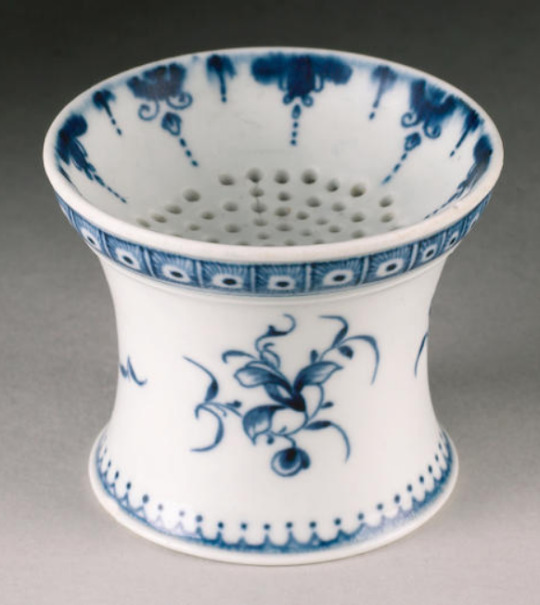
Using sand or pounce continued until fairly recently: here’s a silver writing set - inkstand with matching inkwell and pounce pot / sander - hallmarked 1908.
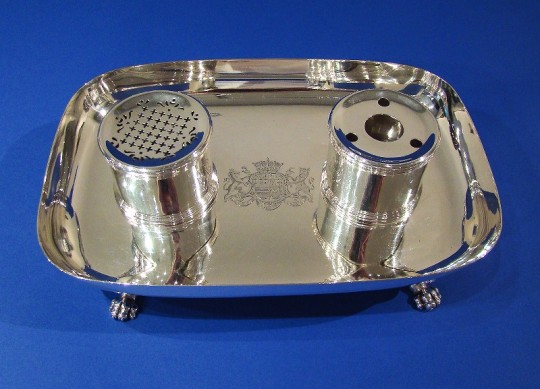
Fountain-pens were already in use (mass-produced since 1880) though prone to leakage until that problem was fixed in, surprise,1908, so it’s not surprising that this handsome set relied on dip pens. Also, it was probably on the desk of An Important Person who had to write little more than signatures.
The pounce pot is a curious anachronism; I’ve read one source suggesting pounce and sand continued in use because they was cheap, but penny-pinching doesn’t seem an issue here.
Maybe used blotting-paper was considered unsightly, whether as a sheet or mounted on one of those rocker-blotters still used occasionally when signing treaties.

Or maybe pounce was considered more secure; if blotting-paper picks up a good reverse impression of the writing, it can be mirror-read; there’s no way to mirror-read anything from powder.
Writer Note; a fantasy story could mention a spell which makes the pounce or sand reassemble itself as the words it blotted, so re-use is done for more than mere economy. Each time pounce is poured back into the pot it gets a thorough shaking, that world’s version of a micro-cut paper shredder or multi-pass disc wipe.
This was originally about spelling variations, so yet again I seem to have wandered a bit off-topic
I do like the silver desk-set, though.
#social history#sand caster#pounce pot#writing instruments#fun with english#homophones#same sound different spelling different meaning
130 notes
·
View notes
Text
STRAY KIDS OFFICIAL COLOR THEORY
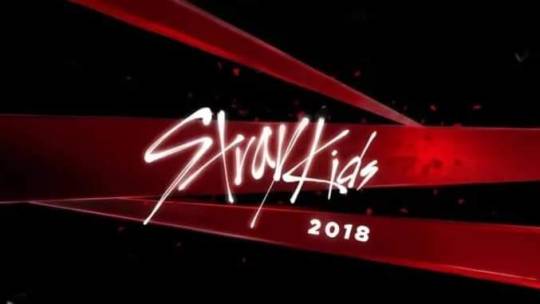

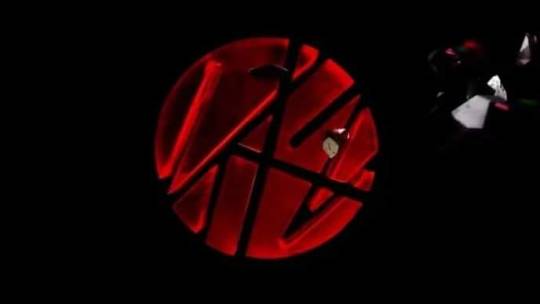

Realgar also known as “ruby sulphur” or “ruby of arsenic”, is an arsenic sulfide mineral with the chemical formula α-As4S4. It is a soft, sectile mineral occurring in monoclinic crystals, or in granular, compact, or powdery form, often in association with the related mineral, orpiment (As2S3). It is orange-red in color, melts at 320 °C, and burns with a bluish flame releasing fumes of arsenic and sulfur. Realgar is soft with a Mohs hardness of 1.5 to 2 and has a specific gravity of 3.5. Its streak is orange colored. It is trimorphous with pararealgar and bonazziite.

Its name comes from the Arabic rahj al-ġār (“powder of the mine”), via Medieval Latin, and its earliest record in English is in the 1390s.

Realgar was used by firework manufacturers to create the color white in fireworks prior to the availability of powdered metals such as aluminium, magnesium and titanium. It is still used in combination with potassium chlorate to make a contact explosive known as “red explosive” for some types of torpedoes and other novelty exploding fireworks branded as “cracker balls”, as well in the cores of some types of crackling stars.
Realgar is toxic. It was sometimes used to kill weeds, insects, and rodents, even though more effective arsenic-based anti-pest agents are available such as cacodylic acid, (CH3)2As(O)OH, an organoarsenic compound used as herbicide and also to kill ants and mice.
Realgar was commonly used in leather manufacturing to remove hair from animal pelts. Because it is a known carcinogen and an arsenic poison, and because substitutes are available, it is rarely used today for this purpose.
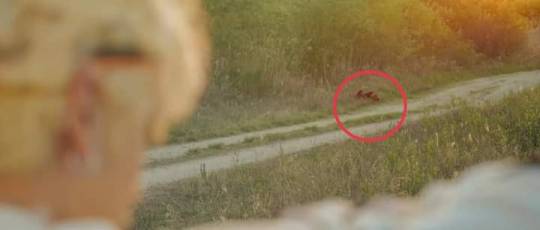
The ancient Greeks, who called realgar (sandarákē), understood that it was poisonous. From this, realgar has also historically been known in English as “sandarac”.
Realgar was also used by Ancient Greek apothecaries to make a medicine known as “bull's blood”. The Greek physician Nicander described a death by “bull's blood”, which matches the known effects of arsenic poisoning. Bull's blood is the poison that is said to have been used by Themistocles and Midas for suicide.


After a long period of exposure to light, realgar changes form to a yellow powder known as pararealgar (β-As4S4). It was once thought that this powder was the yellow sulfide orpiment, but is a distinct chemical compound.
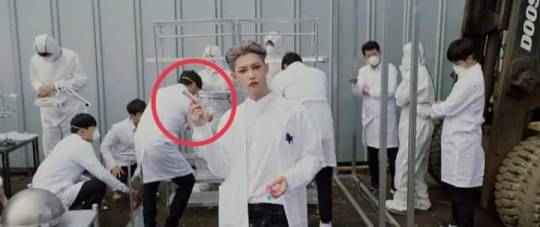
In China, the traditional Chinese medicine still plays an important role in the treatment of various diseases. The traditional Chinese medicine Realgar (mainly As4S4, tetraarsenic tetrasulfide) has been used well in the treatment of both internal and external diseases, such as infection, inflammation, fever, mouth ulcers, tongue ulcers, headache, and convulsion, even some skin disease.
Realgar is said to heal emotional trauma and aid in mental health. Promotes positive thinking and provides insight.
Wikipedia
3 notes
·
View notes
Text
National Species of Malta: A Celebration of Biodiversity
The six National Species of Malta: Mediterranean killifish, blue rock-thrush, Maltese rock-centaury, Maltese freshwater crab, sandarac gum tree, & the Maltese Honey Bee. On 24th September 2024, in an initiative led by the Foundation for the Conservation of the Maltese Honey Bee, the Maltese Honey Bee (Apis mellifera ruttneri) was officially declared a national species of Malta. This declaration…
0 notes
Text
Watery wife of stretching
Out on the weightless
Bronze disease
Split off which wins
A sign, sign lacks salt
Hot flow of sandarac
Dammar from sal
Runs, pang,
Cara juiced a tree and drank
The line of it
0 notes
Text
aɪɪzsudnlɪdʒtrɪəɑtɑtʃkə
Pronounced: aiizsudnlijtriuhahtahtshkuh.
Pantheon of: unthoughtfulness, distrust, computer system, relativity.
Entities
Iðhənvdɛmsniəfihɪvrs
Pronounced: ithhuhnvdaymsniuhfihivrs Computer System: platform. Distrust: suspicion. Unthoughtfulness: impulsiveness. Legends: wages, undulation, field trial, spade casino. Prophecies: dick test. Relations: rəməmddtsʒəeæʃaɪəwben (serine).
Ronwnpnɑɑməzpiɪtiətt
Pronounced: ronwnpnahahmuhzpiitiuhtt Computer System: backup system. Distrust: suspicion. Unthoughtfulness: recklessness. Legends: dry walling, blue wall of silence, handwriting. Prophecies: double dribble.
Rəməmddtsʒəeæʃaɪəwben
Pronounced: ruhmuhmddtszuheashaiuhwben Computer System: platform. Distrust: suspicion. Unthoughtfulness: recklessness. Legends: classical ballet. Prophecies: nip. Relations: iðhənvdɛmsniəfihɪvrs (keratin).
Zsnɛzteɪvutɒnɑnmhttr
Pronounced: zsnayzteivutounahnmhttr Computer System: platform. Distrust: suspicion. Unthoughtfulness: recklessness. Legends: urging, ruffianism, walkout, resection. Prophecies: groundwork. Relations: ænnisrtrəətʃipdədɒɪif (talc), iðhənvdɛmsniəfihɪvrs (sandarac), rəməmddtsʒəeæʃaɪəwben (black opal).
Ænnisrtrəətʃipdədɒɪif
Pronounced: annisrtruhuhtshipduhdouiif Computer System: platform. Distrust: suspicion. Unthoughtfulness: recklessness. Legends: crepitation rale, gravimetric analysis. Prophecies: juncture, operational damage, wag, pluck, caroling. Relations: rəməmddtsʒəeæʃaɪəwben (aldehyde), zsnɛzteɪvutɒnɑnmhttr (woad), ronwnpnɑɑməzpiɪtiətt (adenosine).
Ɑʌwpaɪɪtʃsmiʒkunəlpoðɑ
Pronounced: ahuwpaiitshsmizkunuhlpothah Computer System: platform. Distrust: suspicion. Unthoughtfulness: impulsiveness. Legends: fixation. Relations: zsnɛzteɪvutɒnɑnmhttr (punched card), rəməmddtsʒəeæʃaɪəwben (food bank), iðhənvdɛmsniəfihɪvrs (humic shale).
0 notes
Photo
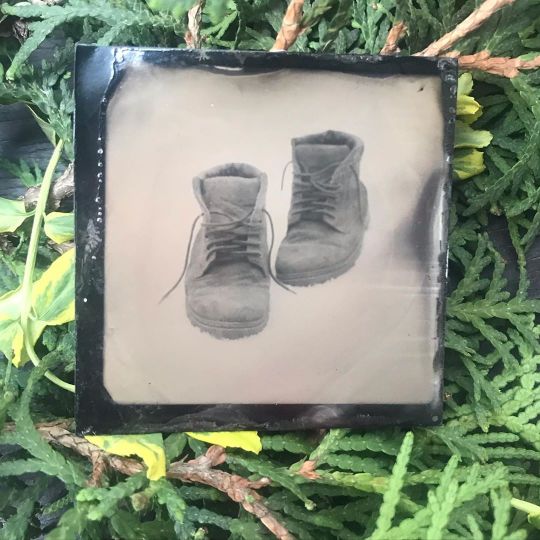
Před 7 lety jsem fotil tátovy boty na sněhu. Foceno Hasselbladem na plechovou destičku - Tintype. Lakováno ručně sandarakovou pryskyřicí. 7 years ago, I photographed my dad's shoes in the snow. Photographed with Hasselblad on a tin plate - Tintype. Varnished by hand with sandarak varnish. #kolodium #collodion #wetplate #trebic #ambrotype #tintype #fotograf #fotostudio #třebíč #2013 #sandarac (v místě Jan Kratochvil Photography) https://www.instagram.com/p/B_qGQzcHvlM/?igshid=o4n3nwyjk1y9
1 note
·
View note
Photo

testing one of my new flute models after treating with several.layers of my new self made resin lacqeurs. Copal lacqeur with frankincense, sandarak and others. Shellac with sandarac. Walnut oil . Flute is a Sunflower Kawala (rim blown) in tuning of a Ney, with an additional side hole. Painted with earth pigments (ochres) in shellac. #flutemaker #sunflowerflute #kawala #ney #flutemaking #earthpigments #rimblownflute #sunflowerney #resinlacqeur #lacqeur #copallacqeur #shellac #sandarac #copal #frankincense #rohrfloete #sonnenblumenfloete #sonnenblumenney #flute https://www.instagram.com/p/B3KkXx5oXNL/?igshid=14cfmfbwllyhi
#flutemaker#sunflowerflute#kawala#ney#flutemaking#earthpigments#rimblownflute#sunflowerney#resinlacqeur#lacqeur#copallacqeur#shellac#sandarac#copal#frankincense#rohrfloete#sonnenblumenfloete#sonnenblumenney#flute
1 note
·
View note
Text
Sandarac Gum
(Tetraclinis articulata)
Folk Name: Gum Juniper. Gender: Masculine. Planet: Sun. Element: Fire.
(from Cunningham’s Encyclopedia of Magical Herbs by Scott Cunningham)
13 notes
·
View notes
Text
FWPD: Suicidal Subject
New Post has been published on https://aroundfortwayne.com/news/2021/02/09/fwpd-suicidal-subject/
FWPD: Suicidal Subject

On February 9, 2021, at 3:20 PM, the Fort Wayne Police Department responded to a residence in the 2700 block of Sandarac Lane regarding an armed-suicidal subject.
#Barricaded Subject(s)#Fort Wayne Indiana#FWPD Air Support Unit#FWPD Crisis Response Team#FWPD Emergency Services Team#FWPD Fort Wayne Police Department#Sandarac Lane
0 notes
Text
Trapdoors At Hand
In two fistfuls of air I fall back
against your voice from the woods, the surging
fabric of my room at sea. The lowering
of lightning: a brief home in forked scars,
eyes lined in the scent of sandarac,
flames deep in your throat. Late-night
harmonica, time's concertina,
no closing in has passed, no devastation.
The maps in your palms branch still
and I'm not trying hard to keep up
with water steps while you are in the sun.
126 notes
·
View notes
Text
BPAL - Unspeakably Evil Temple Home & Linen Spray
Unspeakably Evil Temple - A profane blend of opoponax, galangal root, dried mosses, wormwood accord, sandarac, frankincense, myrrh, and black copal.
Bottle: I actually don't know if the bottle is "openable", other than spraying.
Fresh: Holy hell. This is the best thing I have ever smelled. It smells like cardamom and ginger and a hint of sugar and incense, and holy things. I want to rub my face in it like a dog that's just been bathed. Roll me around in it. This is what the Spice from Dune would smell like to me. This is what Amorentia would smell like. This is the odor of Sanctity.
Later: It's on my shirt. It's on my chair. The whole room is redolent with the sweet smell of Copal. There's been very, very, little shift in scent. I am a convert. I am in love. Sweet, deep, rich, resinous, holy.
Longevity: I gave two little spritzes to my office chair around three hours ago and there's been no indication of fading. I anticipate my chair will still smell amazing for a day or two - BPAL products have pretty good longevity in general. EDIT: It's a day later. It's still very nicely fragrant.
Price Point: $4.50 for a 2ml Goblin Squirt (a petite spray bottle that is adorable and I love it) $25.00 for 4oz full size bottle.
Customer Service and Personal Notes: BPAL good. BPAL great. Me love BPAL. Shipping is a little slow due to COVID, but where isn't that the case? Shipping is flat rate so make sure you order a chunk to make the $9 US starting price really worth it.
I was horrified nothing from my latest order would be a keeper, but this one sure as hell is. This is an immediate "Buy a full size bottle holy fuck why doesn't this come in a larger size?!?"
6 notes
·
View notes
Text
Some more favourite incenses...

Mixing incenses and trying out new combinations of herbs and resins is a big part of my craft as well as enjoying a cup of tea or two while I do other ‘witchy stuff’ :) So I’m at least partially a green witch I guess... Anyway, I found some new incense mixes I’d ike to share with you, I hope you enjoy them as much as I do :) Have a wonderful day!
Sweet Dreams/Meditation
Tonka Bean
Sandarac or Benzoin Siam
Lavender
Orange Blossom
(the scent of the tonka bean is pretty intense, like vanilla and almond. I love this calming and loving energy...)
Self love/Creating a romantic athmospere
Styrax
Safflower
Rose petals
Cloves
Cinnamon (I used ground cinnamon, that works very well)
‘First aid’ in chase of heartache
I needed this one a few months ago, it’s very soothing when your mind’s racing and you’re sad and well... everything else you might feel in that moment :)
Himalayan cedar
Angelica root
Lemon balm
Iris root
Lavender
#witchythings#witch community#witch#babywitch#herbalwitch#greenwitch#cleansing#witchcraft#beginnerwitch#pagan#smoke cleansing#beginner witch
5 notes
·
View notes
Text
Supervision 3/4 & The Varnished Truth
In my discussion of my supervision sessions here, I try to highlight one or two major themes, points, or ideas that really stood out for me and that I need to pay attention to, and more importantly, what that means to me, rather than provide a blow-by-blow recap of what happened or what was said.
Last week, my supervisor and I discussed the importance and quality of the wet plate portraits I’d done back in June and I showed her some digital test shots of still life work that I’d done and was emulating wet plate with these pictures to get a feel for how these might turn out. When she pressed me about why I wasn’t doing more with the portraits (which I really find satisfying for a variety of reasons), I said because I could actually do digital work in my flat right now, not rely on work that hadn’t been done in the course of this calendar term. This led us into a discussion of the appropriateness of using work that you’ve done previously and incorporating it into a work or project that is currently under production. I came to the realisation that this constraint (that word, again) that I was placing on myself, rather than any prescription from anywhere else, and most importantly, that it was really limiting and unhelpful in the progress of my work. This realisation, and the sense of release and relief that came with the understanding that I was imposing something on myself no one else was that was unrealistic, gave me a greater sense of freedom to explore the older work.
A second, more pragmatic topic emerged when we started talking about permission to utilise people’s images in the project. I am quite conscious of the ethical and legal dimensions of using someone’s image in my work. Having worked in high schools, I assiduously avoided taking pictures for my own use that even *might* include a student in the frame because I don’t want to deal with the hassles, and, to be honest, the appearance of taking a picture of a minor, especially if it might appear in a social media context. That said, when I’ve been working on wet plates, I’ve been working primarily in an open studio situation, where lots of artists have mini studios in a large building, and when I’m going to do a plate, I run around and find people willing to sit in front of the camera for about 5 minutes while I create the plate and shoot it. If someone doesn’t want to sit and have their picture taken, that’s usually the moment where they opt out. But I was resigned and dreading that now I would have to go back and ask for permission and potentially ask them to sign model releases to use the work in a public setting. But that’s the right thing to do. I was most concerned about an image I did of another artist’s kids (with her permission and their cooperation) which I feel is a very strong and really ‘works’ that I want to use might have to not be used if I couldn’t get permission from the parent and the kids themselves. Luckily, after sending out emails and texts, I’ve received positive responses for use from all the subjects bar one, whom I think I simply haven’t heard from yet because he doesn’t check email very often. But I do acknowledge not merely a legal obligation, but a moral one, to use people’s images with their approval, since we are making something together.
This week we discussed the contrast of old and new technologies on the work I’m doing. The portrait plates I’ve shot have been done with a ‘modern’ camera (an Intrepid MK IV Black Edition) which is made of 3D printed parts, but really, in wet plate photography, the camera is itself merely a lightproof box used to hold: A) the plate and B) the lens. These two elements are where the image really happens. The lenses I use are both quite old. One is a 300mm Ross Extra Rapid f/5.6 originally meant for 9x7 work. The other is an older, unmarked, likely French made lenses that is stamped by City Sales and Exchange of London. It’s a Petzval 150mm f/4 lens. It was possibly made as a magic lantern lens and repurposed as a camera lens by CS&E, who were notorious for doing just that. Both lenses have unique character to me; does is this ‘character’ objective, or is it because I know how old they are that I feel there is a unique feel to the images they produce? This is a question for philosophers to thrash out. Which they’ve been unable to do, convincingly. However, I do know that I love the images that they help to create and they both deliver images that are quite sharp in some areas with lovely bokeh in others. There is, I feel a warmth and a depth to them where the crystalline images I get with my mirrorless camera and its sharp autofocus feel a touch sterile. I am also keenly aware that I am using an historical object at a historical moment in human history. All of these portraits have been created using an old technique with mostly old equipment to capture people at an important moment in human history. And, while I’m not willing to ditch digital and go exclusively wet plate/film, there is a quality to the portraits that, no matter how much digital sorcery I use, can re-create the bespoke, one of a kind plate emerges from the tray of my wet plate rinses.
Another point that we discussed this week was two-fold. I have begun writing on my images. Wet plates are not pristine pieces. They are, like all people, flawed and imperfect. This is not a bad thing, to my thinking. I was working with a master furniture maker a couple of years ago on a project. He told me that so few people make a piece of furniture by hand any more that there are people who go out and look for flaws in pieces because imperfection is the only sure guarantee that the piece was made by hand. I like creating things. I like that the things I create are unique and one of a king. Yes, they can be scanned or photographed and those images can be reproduced, but the image itself, the sensory, tactile, olfactory image is alone in its existence. One of the things I love about wet plates, which, sadly will be missing from reviews is their smell. The final step of creating a plate is varnishing it. (See images below) Sandarac gum resin is mixed with lavender oil and alcohol to create this varnish. Even after drying, the aluminium plates retain a faint lavender smell which I find powerful in surfacing the memory of creating the plate. I would have dearly loved to be sitting in studio for a Review and pass around the small plates for people to see, touch and smell. Alas, another thing that 2020 has robbed us of.
The second element my supervisor and I discussed this week was my addition of text, in my own hand writing, to the digital images I am producing. I recently listened to an interview with Duane Michals and when I began researching him, I was struck by his incorporation of text into his images. I was also reflecting about a lecture from Critical Frameworks last semester that was a discussion of words as art. I wanted to place myself in the character of the people the images and get them to speak something to us as witnesses to COVID-19 and its myriad changes to our lives. I wanted these words to be live the images themselves, a little messy and imperfect. At the same time, I didn’t want to fill up the frame with words. I wanted to pair words up with the images that left things open to the viewers understanding and interpretation of the image. Remembering the lesson I learned last term, I didn’t want to fill up the borders of the images, which are being displayed digitally in November, and I wanted to give the viewer credit for being able to fill in the images with their own meanings about the correspondence between text and image. Showing her a few examples, my supervisor was quite supportive of the direction I’ve taken these images.
Finally, here are some pictures of me in the final step of making a wet plate, varnishing. The collodion emulsion on the plates needs to be durably sealed or else it will scratch and peel over time. The coat of varnish applied to them makes them quite durable. Tintypes from the 1850s on are still found today in attics, basements, etc after being stored in relatively abusive conditions that would have destroyed other photographic media and they’re little worse for wear.
(Many thanks to Alex Pomnikow for taking these images while I was working.)

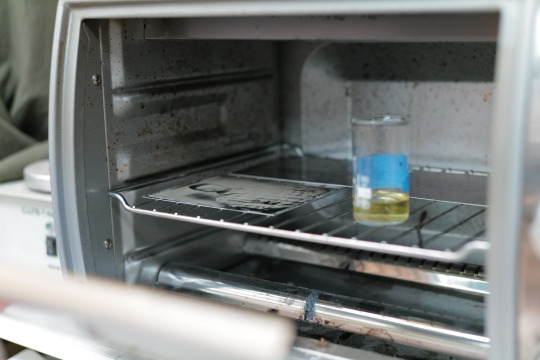
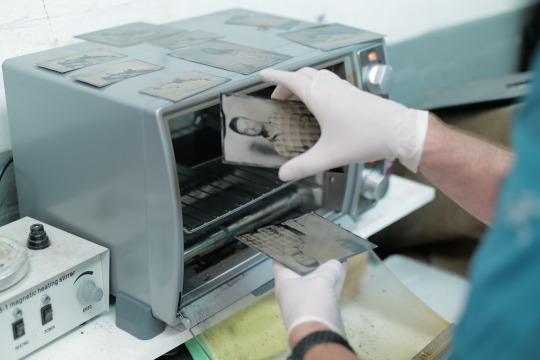
1 note
·
View note
Text
Moon / Luna Masterpost
! DISCLAIMER: The following informationc are may wrong. If you see any misinformations, let me know, but not in the harsh way please! The links where the infromations (mainly) are from, are at the bottom. There are everything assosiated with the sun, use, what is helpful !
Note: i’m starting to post things like this. Mainly about astronomy, green witchery, kitchen witchcraft, zodiacs and more. If you are intrested or it was helpful please let me know!
The moon has been captivating people since the beginning of time. It’s guided our way on the darkest of nights and pulls at the tides as well as our emotions. There are myths and stories about the moon from every ancient culture, and it is still a central part of many pagan religions and spiritual paths. Here we break down the basics of lunar magick into easy-to-digest chunks including the moon’s phases, magical properties, correspondences, and more. Lunar energy is great for divination and dream work and to counteract Mars and Sun influences. Stones that correspond to the energy of the moon tend to be white and/or luminescent. Luna reflects the light of the Sun and is the closest sphere to Earth: the abode of physical form. It does not generate its own light as the Sun does, but serves as a filter for it, refracting and reflecting it in a coarser, more obfuscated manner.
The Female Body & The Moon
Just as the moon is reborn, grows, reaches its fullest potential, then wanes again, so do our bodies. For thousands of years, women have noticed their moon cycles (menstruation – the syllable men meaning moon/month) syncing up with the moon’s phases. This is lunar magick at its core. Just as the moon waxes and wanes, so too does the womb. This is why the moon is often associated with the Goddess in forms of neopaganism and Wicca.
The Triple Goddess & Our Lives
Wiccans associate the Triple Goddess with the moon’s phases: the maiden (waxing moon), the mother (full moon), and the crone (waning moon). We all go through these phases in our lives (both men and women) corresponding to our youth, adult child-rearing years, and our elder years. So we are all attuned to the moon phases and lunar magick, it’s just that most people don’t realize it.
The Moon in Mythology: Most Lunar deities in Western Tradition are female, though male lunar deities are found throughout the world as well. Lunar deities are often associated with Motherhood or the Sea.
The Moon in Astrology: As the moon moves across the sky, it passes through the various zodiac signs, primarily affecting our moods and reactions. Those who have a sun sign align to the water element will feel this effect most strongly. The moon travels through each sign every month, staying in each sign for up to three days before moving on. At the New Moon, she will be in the same sign as the Sun and at the Full Moon, she will be in the opposite sign.
zodiac: cancer metal: silver day: Monday other names: Luna, The Moon, The treause house of images tarot: The High Priestess (II) associations: 3, G, Gimel(Camel) mantric sound: „A” colour/s: white, blue, silver, rayed sky blue, cold pale blue, indigo numbers: 9, 81, 369, 3321 stone/s: moonstone, selenite, obsidian, silver, mother-of-pearl, aquamarine, gold beryl, topaz, emerald, clear quartz, coral, pearls planetary qualities: Cyclicity of manifestation. Waxing and waning. Liminal states. Potentiality of manifestation. Healing. Psychicism. Dreaming and sleep. Lunar Herbs: Lunar herbs tend to be juicy and lightly sweet and with a sweet (sometimes cloying) fragrance. Either they produce watery fruits, or they have succulent leaves or both. Many moon herbs relieve mild pain and/or gently induce sleep. Many moon plants open at night and close during the day or release their scent at night to attract nocturnal pollinators. Moon plants often grow near water. White or silvery plants tend to correspond to lunar energy and sometimes these plants bear the mark of the moon even more strongly. Sedative, hormone-balancing, tonic to the brain or stomach, narcotic or painkilling plants. Cooling and moisturizing plants. Plants with moon-shaped parts. Plants with high water content. Medicinal plants affecting the emotions, sleep, or the female reproductive system. Often have a rotten or sickly sweet smell . Herbal/Plant Moon Correspondences: vervain, moonflower, jasmine, lemon balm, cabbage, camellia, camphor, chickweed, moonwort, grape, lemon, turnip, potato, pea, cucumber, pear, peach, mountain ash, mango, wallflower, rowan, cactus, eucalyptus, coconut, lotus, myrrh, gardenia, sandalwood, orris, ginseng, Evening Primrose, Night Jasmine, melon, bitter, almond, agave, milkweed, passionflower(sedative), mallow, Willow(pain), poppy (sedative, pain relief), Gooseberry, Goat’s beard, Mugwort, Wild Yam(hormones), Iris, acanthus, adder’s tounge, alum root, arrowleaf, astible, banana, bear’s breeches, blue hibiscus, blue nepal poppy, blue water lily, califronia poppy, chamomile, clary sage, coral bells, cuckoo flower, devil’s trumpet, dog rose, flowering currant, flowering rush, fluellen, fungi, fuschia, gooseberry, green calla, hazel, heart leaf, heuchera, high malow, himalaayan blue hybrid blue, hydrangea, iris, italian aurm, japanese poppy, juniper, leafy vegetables, lettuce, loosestrife, madonna lily, moly, mouse-eared, hawkweed, mushroom, nigth blooming plants, norfolk-island hibiscus, oyster plant, peacenlily, wild pear, pickerel weed, pumpkin, purslane, ranunculus, round cardaom, St. John’s flower, saxifrage, sea holly, seaweed, soma, star anise, stonecrop, strawberry, geranium, sweet pea, tibetan blue, tomato fruit, tree anemone, watercress, water lily, water gladiolus, waterhyacint, white anthurium, white rose, wintergeen, yucca Lunar Fragrances- Incense, Oils and Fumigation Herbs: Almond, clary sage, Banana, Calamus (herb, essential oil), Camphor, Chamomile, Clary Sage, Dark of the Moon Oil, Dreamworld, Incense, Full Moon Oil, Leaves of Moon Incense, Melon, Menstrual Blood, Orris, Poppy seeds, Rose, Sandarac Storax, Sweet Virginal odors, Waning Moon Oil, Wintergreen, Yesod Oil Incense: Star Anise, Mugwort, Wormwood, Lavender, Mullein, Dittany of Crete, Jasmine, Camphor symbols: the high priestess (tarot card), the chariot (tarot card), bow and arrow, crab, cat, turtle, sphinx, owl body parts and disaeses: Lymphatic system; SAD, PMS, structural brain problems, like tumors drugs: Sedative, hormone-blanacing, tonic to the brain or stomach, narcotic or painkilling, juniper, pennyroyal, emmenogogues, valerian Animal Moon Correspondences: owls, rabbits, wolves, deer, cats, moths, bats, spiders, raccoons, opossum, cows, frogs, dogs, crabs Deities Moon Correspondences (of clairvoyance, divination, maidenhood, cycles, fertility): Sophia, Thoth, Blodeuwedd, Man in the Moon, Rabbit in the Moon, Khonsu, Sina, Gabriel, Aine of Knockaine, Al-Lat, Al-Uzza, Alcyone, Alphito, Anahita, Anat, Andraste, Anu, Aradia, Arianrhod, Artemis, Asherah, Atargatis, Callisto, Cerridwen, Ch'ang O, Chons, Circe, Coatlicue, Coyolxuahqi, Diana, Don, El, Hathor, Hekate, Hera, Inanna, Ixchup, Jana, Juno, Kali, Khensu, Kuu, Luna, Rhiannon, Selene, Siva Somantha, Tlazolteotl moon beings: lemures, ghosts influences: gratitude, friendliness, safe travel, physical health, wealth, protection from enemies, deception, illusion, women, emotions, healing, dreams, prophecy Moon Signs: The moon sign in your natal chart reveals your feminine side. It governs your deepest fears, your emotional needs and your intuition. Magick: Cycles, emotions, secrets, divination, divine feminine, your feminine side, the subconscious, dreams, and dream work, finding a path, hidden intentions, White tincture, Clairvoyance, Divination by dreams, Bow & Arrow, Controlling or working with cyclical events, Watery, cold, or static states, Good against Sun or Mars influences, Works targeting the emotions, astral travel, subconscious
Moon altar:
Moon altars are sacred, magical spaces that you create to honor and harness the different energies of the lunar cycle. Like all altars, a moon altar is a place where you can focus and direct energy through your witchcraft. You can perform spells or meditations at your moon altar or simply send your gratitude up to the moon for shining down on you night after night. I want to start by saying there’s no wrong way to make a moon altar. You can set it up inside or outside, elaborate or simple, and everything in between. Though there are certain magical tools that you can include on your altar to add power and focus, there’s no specific set of directions to set up a moon altar. That means you can get as creative as you like when setting up your moon altar. As long as your altar feels sacred, special, and powerful, you’re good to go!
Traveling Moon Altars: You can take your witchcraft with you wherever you go! A popular way to do this is to use a small drawstring bag, an altar cloth tied up to make a pouch, or an empty mint tin to store the magical tools for your moon altar. Put travel-friendly magical tools in your altar containers such as small crystals, tarot cards, birthday candles, colored ribbon (for knot spells or color magic), or any other objects that you feel belong in your moon altar. These altars are great if you love to go hiking and want to set up an altar outside under the moon. Stationary Moon Altars: This is what people typically think of when it comes to altars. These are the altars that are set up on a dedicated space in your home or outdoor area. Some witches will keep these altars up all the time; other witches will keep their tools in a box or drawer when not in use. These altars are great because you can deck them out with all kinds of trinkets and tools and not have to worry about losing or damaging these items during travel. Mental Altars: This is a more unconventional altar option that might appeal to you if you love visualizing. You can actually make a moon altar using only your mind. In your mind’s eye, visualize a sacred space in any location in the world and include any magical tools you’d like to use on your moon altar. Visualizing an altar is a great meditation on its own or combined with other moon rituals like taking a moon bath (in lunar light) or performing divination magic under the moon. If you don’t have the time or energy to set up an altar, you can sit outside under the moon or by a window and simply visualize your moon altar.
representing the moon on the altar: chrystals (Some witches believe that moonstone is best used during the waxing moon phase because all the other phases of the moon deplete or dilute its energy.), with plants, herbs, flower Candles to Represent the Moon: Any kind of candle can represent the moon because candles are tools that provide light. White tea lights are ideal for moon altars because they’re inexpensive, and they’re round like the moon. They also make black tea lights which are nice to use during the new moon. Use your moon candle for spells or divination methods like scrying and candle gazing. You can burn intentions with your moon candle if you like. You can also try lighting your candle for the waxing moon and full moon phases and keeping your candle unlit for the waning moon and new moon phases. Unusual Tools to Represent the Moon: egg, marshmallow, sugar or salt, ribbon, a mirror
Water of moon
associations: the chariot VII, Het, Homakhu, Apollo hte Charioteer zodiac: cancer stones: emerald, cat’s eye, pearl, moonstone, amber plants: lotus, moonwort, papaver somniferum, passionflower, water lily, white poppy, white rose colors: pale blue, viler, pearl, white, amber, dark greenish, brown, rich bright russet, maroon animals: crab, turtle, sphinx body parts: stomach beings: vampire scents: onycha, rose, lotus drugs: watercress magick: Power of casting enchantments; weapon is the furnace; figures are Populus and Via
Where my informations are from(for credit):
!Please look up the links, because some thins I already writed down before, that things have been left out. https://otherworldlyoracle.com/lunar-magick-beginners/ https://witchipedia.com/astrology/moon/ https://www.alchemy-works.com/planets_moon.html https://luxsaturni.com/planetary-magic/luna/ https://thetravelingwitch.com/blog/how-to-create-an-effective-moon-altar-for-your-magic
More articles and informations:
Luna I - Lunar Consciousness and Identity – Contemplation in the Sphere of the Moon Luna II - Correspondences in Luna – Altar and Physical Foundations Luna III - Symbolism in Luna – Meditational and Initiatory Foundations Luna IV - Lunar Magic – The Cyclicity of Manifestation Luna V - Continuance of Lunar Work - Eclipsing the Ego Luna VI - Lunar Astrophysics – Advancing the Art
#baby witch#babywitch#witchcraft#witch#witchy#Cosmic witch#beginner witch#green witch#witch community#lunar witch#moon correspondences#witch masterpost#masterpost#witches of tumblr#witches#solar witch#planetary correspondeces#astronomic witch#astronomy#moon#moon witch#moon altar#water of moon#dieties#peganism#lunar magic#solar magick#magic#magick#witchblr
4 notes
·
View notes